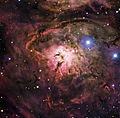Fayl:Lagoon Nebula.jpg

Size of this preview: 610 × 599 pixels. Başqa çözüm: 244 × 240 pixels | 489 × 480 pixels | 782 × 768 pixels | 1.043 × 1.024 pixels | 1.841 × 1.808 pixels.
Kerçek fayl (1.841 × 1.808 piksel, fayl büyükligi: 2,92 MB, MIME çeşiti: image/jpeg)
Faylnıñ keçmişi
Faylnıñ kerekli anki alını körmek içün tarihqa/saatqa basıñız.
| Tarih ve saat | Kiçik resim | En × boy | Qullanıcı | İzaat | |
|---|---|---|---|---|---|
| şimdiki | 00:20, 2014 s. martnıñ 4 |  | 1.841 × 1.808 (2,92 MB) | Lmbuga | Putting the nebula in the center of the image |
| 07:48, 2012 s. avgustnıñ 9 |  | 2.027 × 2.064 (1,59 MB) | Fabian RRRR | higher resolution | |
| 07:32, 2010 s. aprelniñ 22 |  | 1.280 × 1.303 (317 KB) | EricHS211 | {{Information |Description={{en|1=Infrared view of the Cat’s Paw Nebula (NGC 6334) taken by VISTA. NGC 6334 is a vast region of star formation about 5500 light-years from Earth in the constellation of Scorpius. The whole gas cloud is about 50 light-year |
Fayl qullanıluvı
Bu faylnı qullanğan saife yoq.
Umumiy fayl qullanıluvı
Bu vikilerde bu fayldı qullana:
- ady.wikipedia.org qullanım
- alt.wikipedia.org qullanım
- av.wikipedia.org qullanım
- bn.wikipedia.org qullanım
- cs.wikipedia.org qullanım
- cv.wikipedia.org qullanım
- de.wikipedia.org qullanım
- en.wikipedia.org qullanım
- et.wikipedia.org qullanım
- fr.wikipedia.org qullanım
- hu.wikipedia.org qullanım
- kaa.wikipedia.org qullanım
- kk.wikipedia.org qullanım
- koi.wikipedia.org qullanım
- ko.wikipedia.org qullanım
- kv.wikipedia.org qullanım
- lez.wikipedia.org qullanım
- mdf.wikipedia.org qullanım
- mg.wikipedia.org qullanım
- mk.wikipedia.org qullanım
- mrj.wikipedia.org qullanım
- olo.wikipedia.org qullanım
- os.wikipedia.org qullanım
- pl.wikipedia.org qullanım
- pt.wikipedia.org qullanım
- ru.wikipedia.org qullanım
- sah.wikipedia.org qullanım
- sh.wikipedia.org qullanım
- sk.wikipedia.org qullanım
View more global usage of this file.


